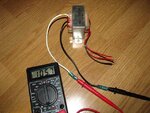barsukas
Newbie level 2
My first post here, might be a stupid questions, sorry if it is.
So, my amp keeps blowing fuses, i took the transformer out, tried to turn it on and it blew a fuse with nothing connected to the secondary windings. Resistance of the primary winding is about 105 ohms, and the fuse is 0.25A 250V, resistance of it is 16ohms. I am really new to electronics, but i think that the resistance of the primary winding is much smaller, than it should be.
Is there a problem with the transformer or could there be something entirely different?

So, my amp keeps blowing fuses, i took the transformer out, tried to turn it on and it blew a fuse with nothing connected to the secondary windings. Resistance of the primary winding is about 105 ohms, and the fuse is 0.25A 250V, resistance of it is 16ohms. I am really new to electronics, but i think that the resistance of the primary winding is much smaller, than it should be.
Is there a problem with the transformer or could there be something entirely different?
